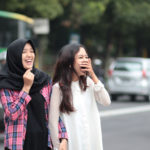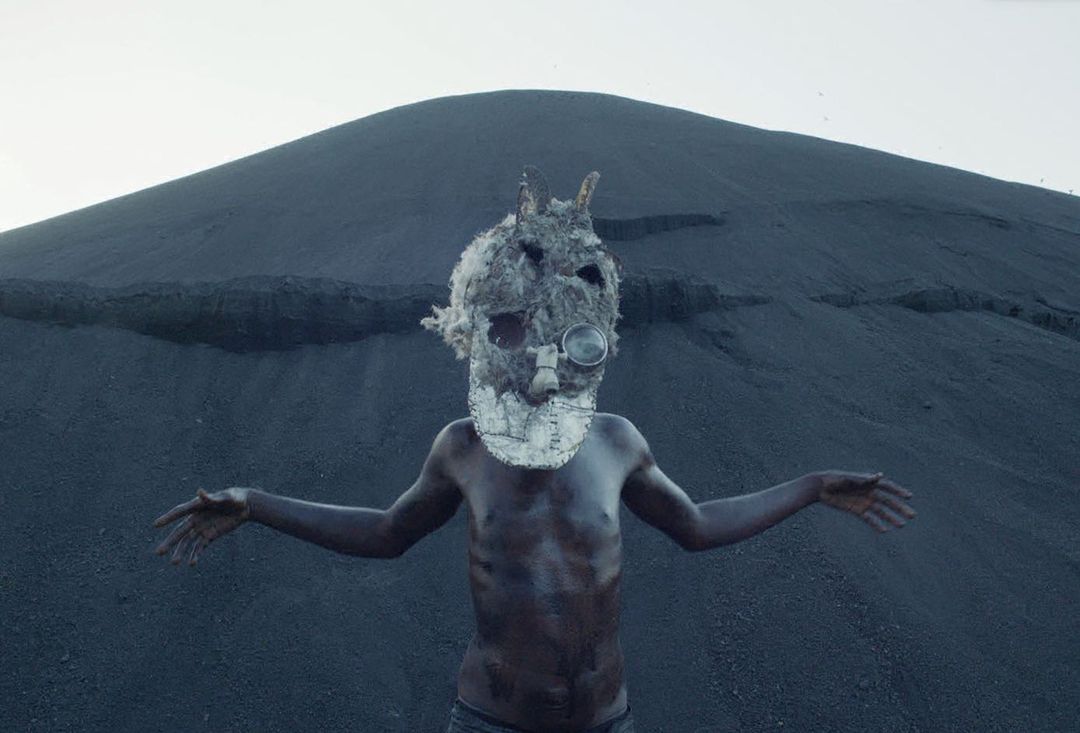John Heartfield and Silvio Berlusconi
2009 - Drawing & Print (Drawing & Print)
240 x 140 cm
Thomas Kilpper
These two images come from the series called “State of Control” which Kilpper made in the building formerly occupied by the Stasi in Berlin. As a symbol of the past there could be none more powerful than this. By carving into its floor, Kilpper laid bare its history by making images of its occupants and political figures associated with that period of history. Willy Brandt, Guenter Guillaume and Dietrich Sperling reminds us of all the intrigue of the Cold War when Brandt’s secretary Guillaume was passing secrets at the highest level to the East. Seen whispering in Brandt’s ear, he is perceived to be feeding false information. Sperling was a minister in Brandt’s government. The photograph on which the image is based was taken at the height of Guillaume’s treachery and treasonous conduct. The image of John Heartfield standing behind Silvio Berlusconi is based on a photomontage of Heartfield with the President of the Berlin Police Karl Zoergiebel of 1929 thus bringing together Heartfield, one of the greatest and most vivid critics of the Nazi era and manipulator of images through collage, with Berlusconi, one of the most rightwing, but freely elected leaders in Europe who manipulates the news and images through his media empire. These images are large scale and have a dramatic impact. In his use of woodcut, Kilpper’s work resonates with the large scale woodcuts of Christiane Baumgartner already in the collection.
Thomas Kilpper’s work engages with history and politics in a manner that recalls the 1960s in terms of his committed engagement. Typically Kilpper takes over a building and investigates its history, carving into the floor to make woodcuts which he then prints on a large scale onto fabric that floats free when he hangs it. In The Ring , a project he made in London in 2000, and of which the Tate bought a substantial part, he investigated the history of the area in which the building of the Tate was situated, making images connected with boxing (the site had previously housed a well known boxing ring), the Ministry of Defense (which had a secret printing press in the building) and Tate Modern (that was about to open around the corner). In Drowning Hercules he used bits of wood from Riddell House, a building about to be demolished to build an oversized tree which he located in the defunct swimming pool. Kilpper’s strategy is to work with buildings condemned for demolition and to use only materials he finds on site to make art. In that respect his work engages with the art of Gordon Matta-Clark but by inscribing himself into the building, rather than simply cutting it up, he puts forward a different point of view. He has no studio, is constantly on the move and starts each project from scratch. Research is a fundamental tool of his practice and the result is normally an artistic intervention into politics and history. Thus Kilpper combines a strong conceptual basis with considerable technical skill in making images that have dramatic impact and presence. Thomas Kilpper was born in Stuttgart, Germany, in 1956. He lives and works in Berlin.
Colors:
Related works sharing similar palette

© » KADIST
Artur Zmijewski
2002Zeppelintribüne (2002) was shot near the Zepelintribune in Nuremberg, designed by Albert Speer, chief architect of the Third Reich...

© » ARTS EQUATOR
International Women's Day: Inspiring Women | ArtsEquator Thinking and Talking about Arts and Culture in Southeast Asia Articles March 6, 2020 By ArtsEquator For International Women’s Day, ArtsEquator asked 11 women arts leaders in SEA to tell us about a woman who has inspired, supported or mentored them on their arts journey...

© » KADIST
Raymond Pettibon
2000Untitled (Wall Street’s Chosen Few…) is typical of Pettibon’s drawings in which fragments of text and image are united, but yet gaps remain in their signification...

© » KADIST
Douglas Gordon
2002Blind Spencer is part of the series “Blind Stars” including hundreds of works in which the artist cut out the eyes of Hollywood stars, in a symbolically violent manner...

© » KADIST
Sergio De La Torre
2008Nuevo Dragon City is a reenactment of a historical event from 1927 in which six Chinese were either trapped or voluntarily hid themselves inside a building in northern Mexico...

© » KADIST
Mungo Thomson
2010In Thomson’s Untitled (TIME) , every front cover of TIME magazine is sequentially projected to scale at thirty frames per second...

© » CONTEMPORARYAND
Baloji and the Art of Averting the Evil Eye | Contemporary And search for something search C& AMÉRICA LATINA EN FR MEMBERSHIP EN FR Editorial All Editorial Features Installation Views Inside the Library Interviews News Opinions Events All Events Art Fairs Conferences Exhibitions Festivals Performances Screenings Talks / Workshops C& Projects C& Artists’ Editions C& Commissions C& Center of Unfinished Business Show me your shelves! C& Education Mentoring Program Critical Writing Workshops Lectures / Seminars Membership Opportunities Print C& Audio Archive On Tour Places Explore IN CONVERSATION INSTALLATION VIEW WE GOT ISSUES DETOX LABORATORY OF SOLIDARITY CONSCIOUS CODES CURRICULUM OF CONNECTIONS LOVE ACTUALLY OVER THE RADAR BLACK CULTURES MATTER INSIDE THE LIBRARY LOOKING BACK Follow About Contact Newsletter Advertise Imprint Data protection Membership Contemporary And (C&) is funded by: Editorial All Editorial Features Installation Views Inside the Library Interviews News Opinions Events All Events Art Fairs Conferences Exhibitions Festivals Performances Screenings Talks / Workshops C& Projects C& Artists’ Editions C& Commissions C& Center of Unfinished Business Show me your shelves! C& Education Mentoring Program Critical Writing Workshops Lectures / Seminars Membership Opportunities Print C& Audio Archive On Tour Places Explore IN CONVERSATION INSTALLATION VIEW WE GOT ISSUES DETOX LABORATORY OF SOLIDARITY CONSCIOUS CODES CURRICULUM OF CONNECTIONS LOVE ACTUALLY OVER THE RADAR BLACK CULTURES MATTER INSIDE THE LIBRARY LOOKING BACK GO TO C& AMÉRICA LATINA About Contact Newsletter Advertise Imprint Data protection Membership In Conversation Baloji and the Art of Averting the Evil Eye Musician, filmmaker, and multitalented artist Baloji talks to C& about his first feature film and how the diasporic relationship gives access to an imaginary world that breaks free from shackles...

© » KADIST
Federico Herrero
2009Federico Herrero’s energetic paintings reflect his experiences on the streets of his native San José, Costa Rica, and in the surrounding tropical landscape...

© » ARTS EQUATOR
Weekly Picks: Malaysia (12–18 Nov 2018) | ArtsEquator Thinking and Talking about Arts and Culture in Southeast Asia Weekly To Do November 12, 2018 Bisikan Monsoon — Open Rehearsal , at Selangor & KL Kwang Tung Association, 13 Nov, 5:30pm An invitation to view the rehearsals for Kwang Tung Dance Company’s Bisikan Monsoon (the show is travelling to China later in the month)...

© » IMA
FIG OUT 2019 | Exhibition | IMA ONLINE FIG OUT 2019 5 July 2019 - 14 July 2019 IMA gallery TAGS IMA gallery FIGLAB session hall Share Title 「FIG OUT 2019」 Dates Friday 5 July, 2019 – Sunday 14 July, 2019 Site IMA gallery /session hall(Tokyo) Time 11:00 – 19:00 Price Free Event Friday 5 July 19:00〜21:00: Opening Reception TAGS IMA gallery FIGLAB session hall Share Staff Picks HANON Présage / Connotations Yoshinori Mizutani Hideyuki Ishibashi...










